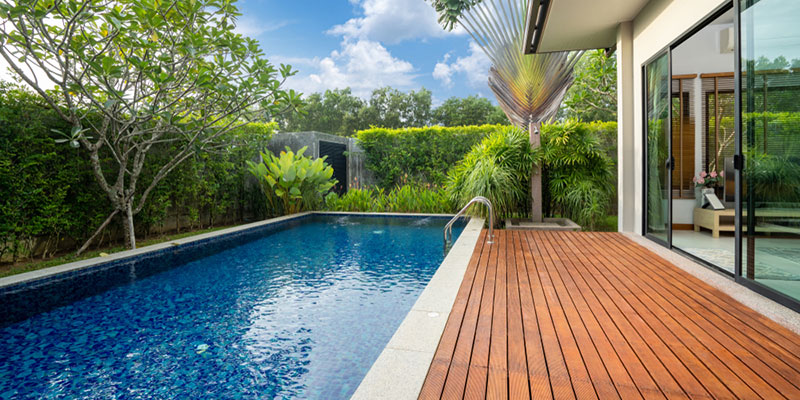How to Paint a Pool Deck and Does Deck Paint Need Primer?

How to Paint a Pool Deck
 Undoubtedly nothing beats a backyard swimming pool deck paint when the residents of the house are aquaphiles. When it comes to pool parties in your backyard, there is a thing people often give priority to. Often, it doesn’t matter to the guests how safe and sound your pool water is, but people judge the host on how your pool deck looks like. So to secure a perfect blue look of the pool water has no more important than the looks of your pool deck. And perfect painting has much important to achieve the perfect look you want for your guests to admire. In this post, I will tell you in detail how to paint your pool deck appropriately. Have fun and be rested, as I shall go through top to bottom of this process.
Undoubtedly nothing beats a backyard swimming pool deck paint when the residents of the house are aquaphiles. When it comes to pool parties in your backyard, there is a thing people often give priority to. Often, it doesn’t matter to the guests how safe and sound your pool water is, but people judge the host on how your pool deck looks like. So to secure a perfect blue look of the pool water has no more important than the looks of your pool deck. And perfect painting has much important to achieve the perfect look you want for your guests to admire. In this post, I will tell you in detail how to paint your pool deck appropriately. Have fun and be rested, as I shall go through top to bottom of this process.
You do not need to get a PhD degree to paint your deck.
It may seem a semi-difficult task, but the results of patience will pay you off well. Now, let’s take it as if we head to do a DIY project.
As we already know, the pool deck refers to the surrounded territory of your pool. Just need to go through four simple systematic processes. Firstly, prepare your deck surface. Secondly, determine the appropriate finish. Thirdly, apply the coating to the deck surface and finally follow recommended steps to protect your surface.
Part 1: Wash Up The Pool Deck
 Cleaning up the surface is an essential job for any paint task.
Cleaning up the surface is an essential job for any paint task.
These dust and sands will cause ruin on a newly painted job, leading to spots and cracks.
Firstly, take a dustpan and a brush for the cleanse of your deck.
Your first priority should be to clean the debris, then you can consider going over to a power washer.
The last step is very much essential if you notice mildew, mold or any other defects.
Part 2: Reduction Of Mold Fungus
Mitigation of mould can play an important role in doing a flawless paint job, although it is not compulsory. We know that powerful dates are continuously getting touched by the elements, this bears a significant risk for mildew and mold. Destruction of mold will ensure a sustained life for your deck. As a result, you can be sure of a hygienic and safe environment.
Apart from this, you can use mold deterrent very comfortably because you can purchase it in the form of spray.
Part 3: Give Time To Dry Your Pool Deck
People often hurry and forget this step. I would say this is the most important step out of all. In conclusion, If you notice wet or any damp from the mold deterrent wait until your deck is completely dry out.
Part 4: Scrapping Of Old Paint And Sanding
 Hence your deck is completely dried, you can proceed to this step. Here you need to scrape out the remains of your old paint job. You can manage it easily with a paint scraper tool.
Hence your deck is completely dried, you can proceed to this step. Here you need to scrape out the remains of your old paint job. You can manage it easily with a paint scraper tool.
Remember, you need to do it on any areas around your pool deck where your old paints are either peeling off or flaky.
In addition, you need to smoothen out each and every freshly exposed wood with the help of a sander. Take note that something in between the range of 80-100 grit is acceptable.
Nonetheless, you might find it necessary to sweep up your deck further after finishing your scraping and sanding role.
Part 5: Wipe Out Remaining Defects
It should be noted that it is important to eliminate any further imperfections. Here you need to repair or even replace flaws if you notice any obtrusive nails or loose.
Similarly, if you find any gaps, holes or scrapes in the wood, you need to repair the damages with the help of any wood filler or putty. Although, I will suggest you to replace the entire board if you find a deep gap of a few inches in the deck.
Part 6: Prepare Your Workspace
Regardless of what painting technique you use, it is essential to determine the zone you will be working at. You can use various methods to deliver this job. It can be done through sheets, tarps and painter’s tape.
Part 7: Making The Workspace Comfortable
Obviously you can work under the sun. It’s totally fine. But it is optimal to paint your deck when your workspace is most in the shade.
This approach will give you a more comfortable position to make the best out of your paint job.
Part 8: Implementation Of Stain
If you need appearance and elasticity, one as well as the other, Spain will be a good bait. You need to just apply 1 to 2 coats of stain and wait for 8 to 12 hours to dry it out completely to proceed in the final painting job.
Part 9: Going Through Paint Job
Finally, we are in a position to proceed with the paint job. Here is a tip, always start from the high and work through to the bottom. To put it differently, firstly do paintings on the railings, posts or railings and only then proceed down to the boards. Hence, it will greatly help you to navigate the work zone very comfortably and easily.
You can use either a paint sprayer or a roller/brush to apply the paint.
Some Methods to Paint Your Deck
Method 1: Using A Paint Sprayer
The paint sprayer is pretty straightforward. Just apply the paint coating on the target area. But to get the best results, you need to keep the sprayer’s nozzle within some inches from the surface. Beware of over-spraying as it can ruin your whole paint.
Method 2: Using A Roller/Brush
This process is also very easy to follow. You need to just apply the grain to at least three coats to get the best results. Importantly, always remember to apply an additional coating after you give the paint at least 6 to 8 hours to dry.
Does Deck Paint Need Primer?
 Painting your deck is an excellent way to bring dynamic color to your home and its surroundings. Many house owners nowadays opt for painting stairs and railings but prefer to stain the deck. It is for their wrong assumption that stain is more flexible in foot traffic than paint.
Painting your deck is an excellent way to bring dynamic color to your home and its surroundings. Many house owners nowadays opt for painting stairs and railings but prefer to stain the deck. It is for their wrong assumption that stain is more flexible in foot traffic than paint.
But painting your deck can be a more practical approach than facing the nuisance of stains. And if you apply a good quality primer on every corner of your deck then it can give you amazing durability. So it is definitely a wise decision to use a primer with deck paint.
Though it will consume tedious hours to prime all sides of your deck individually, yet it’ll fend off any moisture from underneath. Therefore your deck will be quite stable and dry. Otherwise, drastic and unexpected changes in humidity and moisture can expand and compress your decking board, lessening the life expectancy of your paint. So priming is a good choice you should take.
Basic Theory of Primer.
To get the best result out of your paint job, prime the deck with new quality sealer. Sealers usually have a high density of resins that cover up old paint, lock everything in place and create a good surface for the new paint. If you’re going to repaint a wall or deck which is filled with dust, you would get the most benefit out of a chalky type primers. Obviously, paint will not stick easily to a dusty deck. So, for these types of dusty decks as well as for old walls you can apply primer without much hesitation. Otherwise, the effectiveness of your deck painting will diminish to a great level.
If you consider applying primer on a new deck, latex primer is highly recommended. This is because an extra coat of this primer has given satisfactory painting performance so far– from old wood to new wall, from painted brick to bare metal- almost anything you have in your repertoire of imagination.
The main property of a primer is sticky sort of substance, that is essentially meant to stick fast and therefore to offer a solid base for an effective paint. The lack of primer application will bring some extra chunk of manual labour to coat and recoat your deck. Instead of excessive coating you should opt for applying primer. And it is commonly acknowledged that only painting will not cling to the deck for a satisfactory period of time.
Benefits of Primer
- If you apply a quality primer over a new deck, the surface will be sealed easily. As a result, the paint won’t be invalidated by succumbing into the deck itself.
- Primer generally helps to conceal unwanted joints, cracks and crevices on drywall or deck; and it also prevents any cracks to form and expand in your deck.
- Primer has certain properties that can seal over marks and other discolorations to stop them from peeping through the finished coating of paint.
- Primers are widely applicable to various metal and wood surfaces. And they are undeniably important for the exact bonds of any painting.
Primer Color
Primers are usually available in white color, but there are other various colors as well to choose from. Unsurprisingly enough, it can provide the capacity to unravel the true complexion of a deck as well as the capability to stick tight to the object. Well, there is another thing to remember here. If you mixture a small pigment with the primer, it will help you to explore the true beauty of a primer. You can use that little amount without an iota of doubt. However, it is always advisable to use primer neutrally to get the utmost benefit. And it will ensure crystal shining of your final painting if added without pigments.
Oil-Based Primers
 Generally, an oil-based primer is considered to be one of the best liquids, if not the best liquid, for cabinets, windows or similar objects.
Generally, an oil-based primer is considered to be one of the best liquids, if not the best liquid, for cabinets, windows or similar objects.
Oily primers demand genuine mineral type of spirits for their clean up process.
These are considerably excellent substances to seal over stubborn, problematic woods.
Today we have some primers that are specifically designed to fight against any sort of unlikable surfaces.
In addition, you need to smoothen out each and every freshly exposed wood with the help of a sander. Take note that something in between the range of 80-100 grit is acceptable.
Water-Based Primers
 Water-based primers, also widely known as latex primers, are amazing for blocking unexpected stains and erasing previous marks.
Water-based primers, also widely known as latex primers, are amazing for blocking unexpected stains and erasing previous marks.
These primes are determined to offer a great, promising completion with fine crack resistance. And it is often recommended by painting experts to use these primers on new decks, walls and uncovered wood.
But for some extra safety measurements, you should test it on a chunk of your home to know whether it works properly or not.
A good percentage of water-based primers are very popular today and they are used on expensive masonry, simple plaster, and metal, based on their specific procedures of usage.
Paint-and-Primer-in-One
It is quite interesting that a blending of paint and primer is available in just one product. It is specifically designed to seal and cover surfaces in one single coating. These products usually have their magnum opus performance on wooden decks, newly-built drywall or on previously painted surfaces. And the coverage it shall provide is a decent one as well. However, the formula is a bit thicker than normal primers. Therefore it means that there can possibly be some cases of performance drawbacks. So it is not recommended to use them on highly trodden areas of a deck.
So you can use either oil-based or water-based primers — both of which have their respective pros and cons. Oil-based paints usually dry slower than the latex one. It can consume some extra couple of hours from your holiday; but the quality will be better of course. On the other hand, a water-based latex primer takes less time to dry up and its performance is also satisfactory.
Finally, it should be mentioned here some final judgements on using primers. Primers are happened to be less expensive than any quality topcoat. The main benefit you shall be getting from a primer is that it will seal or block unnecessary cracks or crevices to rise over your topcoat. If your decks are already painted with any sort of graphics or quality paints, then it is not recommended to prime the finished deck again. What you can do here is, priming the immediate vicinity of the painted deck to make it more compatible and durable.
We conclude here with the vital question of the title. Does deck paint need primer? Probably your answer will be yes, as will be ours. So take the step toward refining your paint today and get an ever-green deck in your home.
- Best Deck Paint – Reviews and Buyer’s Guide
Final Thoughts:
I have illustrated all the points at my best. You don’t need to worry at all now. Just follow all these steps and you will be glad to see the results. I am very much positive that you will find it very easy to go through your paint task and the output will satisfy you the best.




